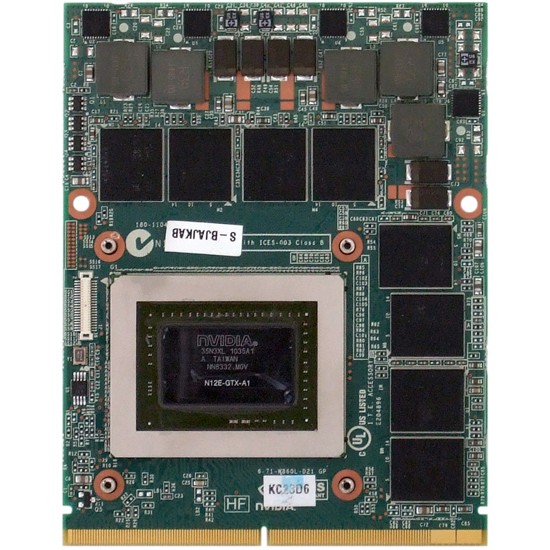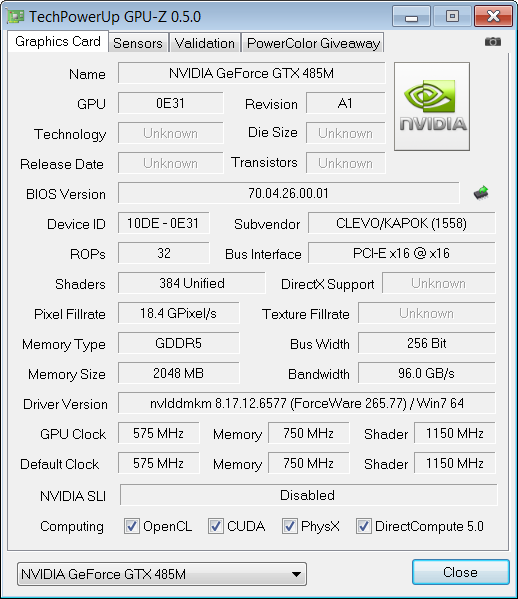MALIBAL's Lotus P150HM: GeForce GTX 485M Gets Its Game On
Using the latest advances from Intel and Nvidia, MALIBAL attempts to prove that portability and performance are no longer mutually exclusive. Can a fully-loaded Lotus P150HM meet the needs of performance enthusiasts and gamers at a more reasonable price?
Nvidia’s GeForce GTX 485M
Nvidia’s GTX 485M looks almost exactly like its most recent preceding product, and there’s a good reason for that.
It appears that this is a different version of the same IC, with the added memory expanding its bus width from 192- to 256-bits. We pressed further to see exactly how this GPU stacked up to its relatives.
We had heard that the GeForce GTX 470M would have the “fully functional” version of the desktop GeForce GTX 460’s GPU. But as it turns out that honor was reserved for the GeForce GTX 485M. The GTX 460 was a great card for its time, even winning our coveted awards for both its single-GPU performance-value and its amazing SLI scaling. Naturally we have high hopes for it here.
| Desktop Versus Mobile GeForce Graphics | ||||
|---|---|---|---|---|
| Row 0 - Cell 0 | Desktop GeForce GTX 560 Ti | GeForce GTX 485M | Desktop GeForce GTX 460 SE | GeForce GTX 470M |
| Transistors | 1.95 billion | 1.95 billion | 1.95 billion | 1.95 billion |
| Engine Clock | 822 MHz | 575 MHz | 650 MHz | 535 MHz |
| CUDA Cores | 384 | 384 | 288 | 288 |
| Texture Units | 64 | 64 | 48 | 48 |
| ROP Units | 32 | 32 | 32 | 24 |
| Compute Performance | 1.26 TFLOPS | 883.2 GFLOPS | 855 GFLOPS | 634 GFLOPS |
| DRAM Type | GDDR5-4000 | GDDR5-3000 | GDDR5-3400 | GDDR5-3000 |
| DRAM Interface | 256-bits | 256-bits | 256-bits | 192-bits |
| Memory Bandwidth | 128 GB/s | 96 GB/s | 108.8 GB/s | 72 GB/s |
| TDP | 170W | 100W | 150W | 50W (GPU Only) |
Notice that the GeForce GTX 485M’s main specs closely match the GeForce GTX 560 Ti. Nvidia remains mum on whether the GTX 485M is based on the GTX 460’s original GF104 core or GTX 560 Ti’s revised GF114 (Ed.: all indications point to this being GF104), but we’re certain that the clock-optimizations made in the GTX 560 Ti conversion are not needed at the GTX 485M’s lower frequencies.
Nvidia is going further to enhance the power-to-performance of its top-end notebook model. Though, like all of Nvidia’s notebook parts, value has been forcefully thrown kicking and screaming out the top-floor window of a 32-story building, its remains stamped into dust by Nvidia’s marketing department.
According to the price sheets of various Clevo partners, this bare module costs approximately four times as much as a theoretical 2 GB desktop GeForce GTX 460 with all of its insides turned on. We blame neither Clevo nor MALIBAL, as this appears to be specifically related to Nvidia’s mobile GPU pricing structure. To be fair, AMD employs a similar practice, marking up its own mobile parts to cost significantly more than their desktop equivalents.
We're sure both companies would try to justify the increase with discussions of thermal engineering and volume. But it's hard to ignore the naming that at least suggests you're getting something as fast as a GeForce GTX 480 (there is no 485 on the desktop) or Radeon HD 6970, when in fact these are lower-performance versions of derivative chips (in Nvidia's case) or completely different architectures (in AMD's). This is one of those situations where it certainly pays to educate yourself before buying. Customers who don't, and end up drawing those parallels between mobile and desktop model names, are setting themselves up for disappointment.
Get Tom's Hardware's best news and in-depth reviews, straight to your inbox.


